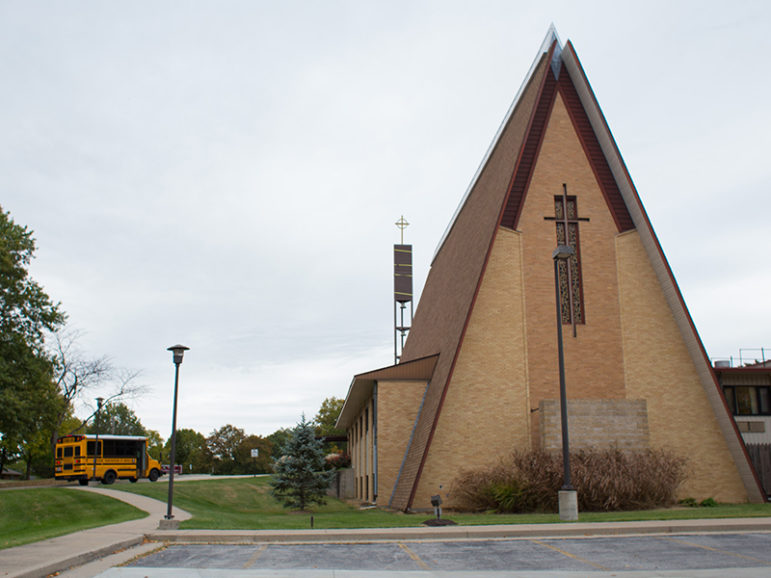(RNS) The ’Splainer (as in “You’ve got some ’splaining to do”) is an occasional feature in which the RNS staff gives you everything you need to know about current events to hold your own at the water cooler.
This week, the Supreme Court ruled in favor of a Columbia, Mo. church-run day care center seeking state funding for some chopped-up tires for its playground surface. At issue was the Missouri Constitution’s Blaine-type Amendment, which the state claimed prevented giving money — even for playground equipment — to a religious institution. The court ruled in favor of Trinity Lutheran Church. Was this the death knell for the little-known but widespread Blaine Amendment? Who was Blaine and would he have wanted to prevent a Midwestern day care center from padding the ground below its swing set and slide? Let us ’Splain …
What is the Blaine Amendment and where does it live?
The original Blaine Amendment was proposed in 1875 by James G. Blaine, a Republican U.S. representative from Maine who served as speaker of the House. He wanted to prevent government money from funding religious schools so he proposed a constitutional amendment intended to fortify the First Amendment’s establishment clause — the one about the separation of church and state.
But Blaine’s amendment didn’t pass. Instead, states took it up, and many put it in their constitutions. Fun fact — some legal scholars point out that several state constitutions have similar clauses that pre-date the Blaine Amendment, so they prefer the term “no-aid amendments.” In fact, many signed an amici brief in Trinity Lutheran case stating just that. Today, 37 states, including Missouri, have Blaine-type amendments on the books.
Why did Blaine want to emphasize the establishment clause? Isn’t it strong enough to keep government funds out of religious institutions?
To the time machine! Set the dial to the late 19th century. At that time, there was an influx of Catholic immigrants to the U.S., prompting a wave of anti-Catholic sentiment. This is also the time public education flourished. But Catholics were concerned by the Protestant religious practices that were then commonplace in public schools — daily Bible readings, prayer, etc. — but all from a Protestant perspective.
Catholics established their own parochial schools. The original Blaine Amendment was an attempt — some legal scholars say a biased one — to ensure no public money went to Catholic schools.
The establishment clause expressly prohibits government establishment of a religion. Blaine Amendments deal only with money. So the establishment clause is used to argue over creches or crosses on public land while Blaine Amendments are used to keep money from advancing a religious belief or a religious group.
And that is where things get tricky; not all Blaine Amendments are the same. Some are more restrictive than others. Florida, Georgia, Colorado, Wisconsin, Arizona and Ohio all have Blaine Amendments on the books, but they have reached different decisions in cases involving school vouchers and religious schools.
So what’s the big deal about this week’s case and the decision for the church?
The big deal is what it may mean for voucher programs. Even though the issue in Trinity Lutheran v. Comer was playground equipment, some see the court’s 7-2 decision in favor of the church as a sign that school voucher programs, which both President Trump and Education Secretary Betsy DeVos support, would survive future legal challenges. Currently, more than a dozen states have school voucher programs that involve religious schools.

Gravel paves the playground of Trinity Lutheran Church’s Child Learning Center in Columbia, Mo., on Oct. 18, 2016. RNS photo by Sally Morrow
“This decision has implications beyond scrap tires and church playgrounds,” Michael Bindas, an attorney with the Institute for Justice, said in a statement. “The Court’s reasoning sends a strong signal that, just as the Court would not tolerate the use of a Blaine Amendment to exclude a religious preschool from a playground resurfacing program, it will not tolerate the use of Blaine Amendments to exclude religious options from school choice programs.”
But don’t plan a funeral dirge for the Blaine Amendments yet. Secular groups have pledged to fight. Americans United for Separation of Church and State called the ruling “harmful.”
“The religious freedom protections enshrined in state constitutions are worth more than resurfacing a playground,” the Rev. Barry Lynn, AU’s outgoing executive director, said in a statement. “This ruling threatens to open the door to more taxpayer support for religion, which is at odds with our history, traditions and common sense.”





